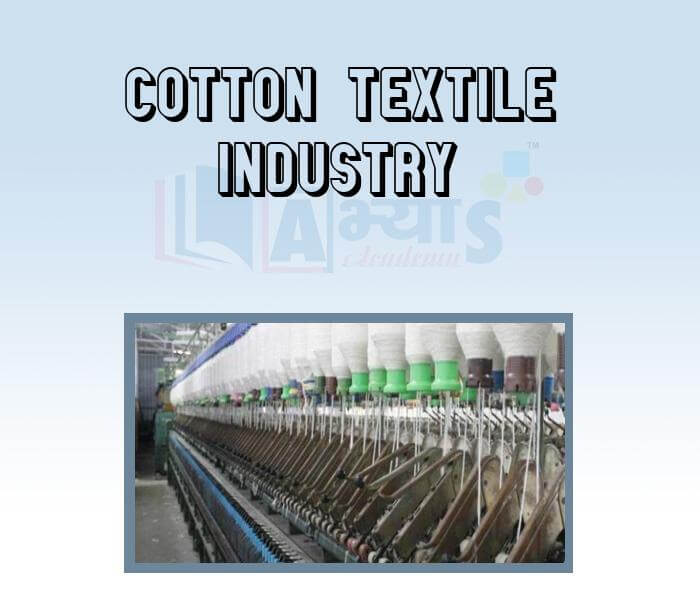Cotton Textile Industry


Cotton Textile Industry
Cotton Textile Industry: the textile industry can be divided on the basis of raw materials used in them. Fibres are the raw material of textile industry. Fibres can be natural or man-made. Natural fibers are obtained from wool, silk, cotton, linen and jute. Manmade fibres include nylon, polyester, acrylic and rayon.
The cotton textile industry is one of the oldest industries in the world. Till the industrial revolution in the 18th century, cotton cloth was made using hand spinning techniques (wheels) and looms. In 18th century power looms facilitated the development of cotton textile industry, first in Britain and later in other parts of the world. India has a glorious tradition of producing excellent quality cotton textiles. Before the British rule, Indian, hand spun and hand woven cloth already had a wide market. The Muslins of Dhaka, chintzes of Masulipatnam, Calicos of Calicut and gold- wrought cotton of Burhanpur, Surat and Vadodara were known worldwide for their quality and design. The first successful mechanized textile mill was established in Mumbai in 1854. The warm, moist climate, a port for importing machinery, availability of raw material and skilled labour resulted in rapid expansion of the industry in the region.
Early Phase of Cotton Textile Industry in IndiaIn the early years, the cotton textile industry was Concentrated in the cotton growing belt of Maharashtra and Gujarat because of availability of raw cotton, a good market,transport includ.ng accessible port facilities,casily available labour, moist climate, etc. In present time, spinhing industry continues to be centralised in Maharashtra, Gujarat and Tamil Nadu. Weaving industry is highly scattered tor incorpcrating traditional skillsnd designs of weaving in cotton, silk, zari, embroidery, etc.
Employment Generation through Cotton MillsThis industry provides livelihood to farmers, cotton boll pluckers and workers engaged in ginning, spinning, weaving, dyeing,designing, packaging, tailoring and sewing. By creating demands for additional materials, it supports chemicals and dye industries, mill stores, packaging materials industry and engincering works. The handspun khadi provides large scale employment to weavers and is important as a cottage industry.
India as a Cotton Exporter: India exports yarn to Japan as well as to other Countries like France, USA, UK, Russia, European countries, Nepal, Singapore, Sri Lanka and African countries. It has the second largest installed capacity of spindles (43.13 million) in the world in 2011-12 next to China. Its share is 25% in the world trade of cotton yarn. But, our trade in garments isonly 4% of the world's total.NÆ¡w our country has spinning mills that can compete at global level. There are some large and modern factories in these segments, but most of the production is in fragmented small units, which cater to the local market. This mismatch between spinning and weaving reSults in many of our apparel/garment manufactures importing fabric while spinners export cotton yarrn.
Challenges for Cotton Textiles Industry: Cotton Industries have made significant increase in the production of good quality long staple cotton (356 lakh bales of 170 kg each during 2011-12), but the need to import is still there because of high demand. The industry suffers from problems like outdated machinery (leading to low productivity), irregular power supply and stuff competition from the synthetic fibre industry.
During Indus valley civilisation period Indian cotton fabrics were of great demand in _____________________ | |||
| Right Option : B | |||
| View Explanation | |||
Which one of the following statement is correct? | |||
| Right Option : A | |||
| View Explanation | |||
_______________ are the raw material of textile industry. | |||
| Right Option : C | |||
| View Explanation | |||
Students / Parents Reviews [10]
It was a good experience with Abhyas Academy. I even faced problems in starting but slowly and steadily overcomed. Especially reasoning classes helped me a lot.

Cheshta
10thI have spent a wonderful time in Abhyas academy. It has made my reasoning more apt, English more stronger and Maths an interesting subject for me. It has given me a habbit of self studying

Yatharthi Sharma
10thIt was good as the experience because as we had come here we had been improved in a such envirnment created here.Extra is taught which is beneficial for future.

Eshan Arora
8thAbhyas Methodology is very good. It is based on according to student and each child manages accordingly to its properly. Methodology has improved the abilities of students to shine them in future.

Manish Kumar
10thMy experience with Abhyas academy is very good. I did not think that my every subject coming here will be so strong. The main thing is that the online tests had made me learn here more things.

Hiya Gupta
8thOne of the best institutes to develope a child interest in studies.Provides SST and English knowledge also unlike other institutes. Teachers are co operative and friendly online tests andPPT develope practical knowledge also.

Aman Kumar Shrivastava
10thA marvelous experience with Abhyas. I am glad to share that my ward has achieved more than enough at the Ambala ABHYAS centre. Years have passed on and more and more he has gained. May the centre flourish and develop day by day by the grace of God.

Archit Segal
7thIt has a great methodology. Students here can get analysis to their test quickly.We can learn easily through PPTs and the testing methods are good. We know that where we have to practice

Barkha Arora
10thMy experience was very good with Abhyas academy. I am studying here from 6th class and I am satisfied by its results in my life. I improved a lot here ahead of school syllabus.

Ayan Ghosh
8thMy experience with Abhyas is very good. I have learnt many things here like vedic maths and reasoning also. Teachers here first take our doubts and then there are assignments to verify our weak points.
